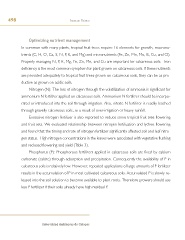Page 498 - FRUTAS DEL TRÓPICO
P. 498
498 Frutas del trópico
Optimizing nutrient management
In common with many plants, tropical fruit trees require 16 elements for growth, macronu-
trients (C, H, O, Ca, S, N, P, K, and Mg) and micronutrients (Fe, Zn, Mn, Mo, B, Cu, and Cl).
Properly managing N, P, K, Mg, Fe, Zn, Mn, and Cu are important for calcareous soils. Iron
deficiency is the most common symptom for plant grown on calcareous soils. If these nutrients
are provided adequately to tropical fruit trees grown on calcareous soils, they can be as pro-
ductive as grown on acidic soils.
Nitrogen (N): The loss of nitrogen through the volatilization of ammonia is significant for
ammonium N fertilizer applied on calcareous soils. Ammonium N fertilizer should be incorpo-
rated or introduced into the soil through irrigation. Also, nitrate N fertilizer is readily leached
through gravelly calcareous soils, as a result of over-irrigation or heavy rainfall.
Excessive nitrogen fertilizer is also reported to reduce some tropical fruit tree flowering
and fruit sets. We evaluated relationship between nitrogen fertilization and lychee flowering
and found that the timing and rate of nitrogen fertilizer significantly affected soil and leaf nitro-
gen status. High nitrogen concentrations in the leaves were associated with vegetative flushing
and reduced flowering and yield (Table 3).
Phosphorus (P): Phosphorous fertilizers applied in calcareous soils are fixed by calcium
carbonate (calcite) through adsorption and precipitation. Consequently the availability of P in
calcareous soils is relatively low. However, repeated applications of large amounts of P fertilizer
results in the accumulation of P in most cultivated calcareous soils. Accumulated P is slowly re-
leased into the soil solution to become available to plant roots. Therefore growers should use
less P fertilizer if their soils already have high residual P.
Universidad Autónoma de Chiapas

